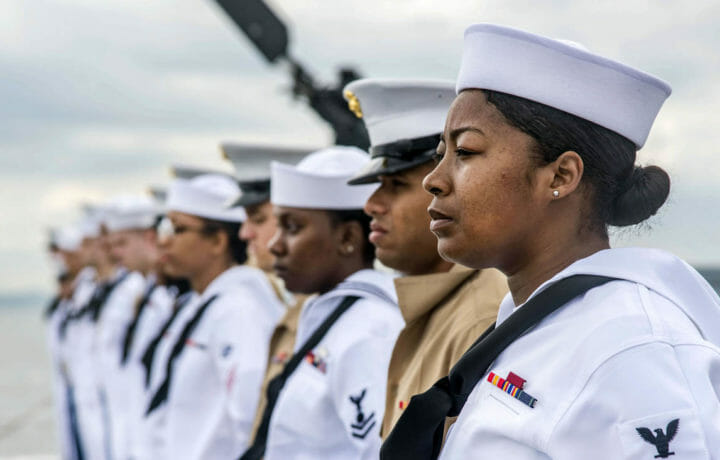The United States Navy continues to face challenges in recruiting and retaining sailors, and it continues to respond accordingly. It has already relaxed some education requirements, including no longer requiring a GED or high school diploma, while last year the U.S. Navy allowed recruits in two divisions “limited access” to mobile devices during designated periods of training.
The sea service will now ease the physical fitness rules for some active-duty service members. However, sailors shouldn’t plan on loosening their belts, nor is the Navy entirely loosening the fitness tests. Instead, the Bureau of Naval Personnel will now allow sailors who fail two fitness assessments in a row to stay in the Navy, and have an opportunity to try again, provided their commanding officer agrees.
Two Fails Was an Out!
Previously sailors could only fail a single physical fitness assessment (PFA) and remain at their post, while a demerit would be marked in the record. Sailors who failed to pass would also be placed in their command’s mandatory physical fitness program, and until their performance improved, they would be ineligible for a promotion. Those who failed two PFAs in a row would receive a failing score and would be ineligible to re-enlist in the Navy.
The new policy, which went into effect on June 18, will no longer result in automatic marks on a sailor’s annual evaluation, and instead, their health will be observed and considered by their commanding officer.
Vice Adm. Richard Cheeseman, chief of naval personnel, explained the changes in a June 24 notice, in which he wrote, “Navy’s Culture of Excellence 2.0 charges our leaders to build great people, great leaders, and great teams: their minds, bodies, and spirits, eliminating barriers wherever possible. In response, we are modernizing our
PFA policy to acknowledge our diverse population, increase Sailor trust, and enhance quality of service.”
The notice further announced that the Navy will conduct only a single Calendar Year (CY) 2025 Physical Fitness Assessment (PFA) cycle. The U.S. Navy’s new policy will also continue to push a healthy lifestyle.
“Building the bodies of great people is more than annual (or biannual) testing and includes ensuring healthy food, adequate sleep, opportunities to exercise (especially outside), and medical readiness. Commanding Officers (COs) are able to evaluate a Sailor’s physical readiness progress or lack of progress in performance evaluations, giving them the ability to manage risk, recognize earnest effort, and best take care of their people,” Cheeseman added.
Gym Time Anytime
To help sailors stay fit, earlier this year, the Navy Installations Command announced it would make its gyms and fitness centers available 24 hours a day, seven days a week at all 70 Navy bases around the world.
“If we require our Sailors to be physically fit and healthy so they can fulfill the Navy mission and deploy at a moment’s notice, then we must provide the facilities and resources for them to do so,” said Vice Adm. Scott Gray, commander of Navy Installations Command. “Not only does this make sense, it is the right thing to do for the quality of life of our Sailors and other service members.”
Due to staffing issues, some fitness centers may be staffed or unstaffed outside normal business hours – and before instituting unstaffed fitness facilities, installation commanding officers will be required to conduct an initial operational risk assessment to be certified by the base’s safety office, while standard operation procedures will be developed to ensure the safety of sailors and other authorized patrons. That could include restricted access to aquatic spaces, but the goal of the change is to accommodate those sailors who may be on duty during normal fitness centers’ previous normal hours of operation.
“Maximizing access to fitness facilities makes it more convenient for our Sailors,” Gray added. “We all know that exercise benefits one’s physical health, but it also reinforces mental, emotional, and social health, which are important for our Sailors’ overall wellbeing.”
Changing Physical Requirements in the Digital Age
The new U.S. Navy policy on fitness also comes as some critics have suggested that a “standard” for all sailors (even all military personnel) is no longer apt in the digital age. In April, a U.S. Naval Institute report suggested that today’s cyber warriors may look different from the traditional service members and that current recruiting guidelines fail to address that fact.
“Physical fitness has long been the bedrock of a prepared and effective fighting force. But the predigital world was a fundamentally different one, and assumptions about what makes a ‘good’ cyber warrior must be reevaluated,” authors Annabelle Hutchinson and Madison Poe wrote in the report, and added, “The technology used in cyber warfare is not reliant on physical strength. Most cyber warriors currently operate from the relative security of the United States where technical machinery is better protected from hostile actors.”
The report suggested that guidelines should be further changed to address the needs and expectations for the role. Doing so could ease recruiting challenges, especially in a tight labor market for those with cybersecurity and IT skills.
While the U.S. Air Force airmen must already deal with the suggestion that they’re part of the “Chair Force,” an actual cadre of future warriors could live up to that moniker – but instead of seeing it as an insult, they could wear it as a badge of honor.




